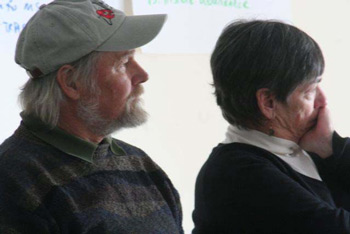Scientists, Fishermen Set Research Agenda
by Laurie Schreiber

Carl Wilson, DMR biologist.“We’re managing the Gulf of Maine as one system, and that’s probably not appropriate.” Wilson is among the state's top lobster scientists tasked with setting the research agenda for the resource. Laurie Schreiber Photo
About two dozen people – including fishermen, researchers and officials with the Maine Lobstermen’s Association, Down East Lobstermen’s Association, Lobster Institute, Department of Marine Resources, Gulf of Maine Research Institute and University of Maine Sea Grant – attended a December 9 meeting in Ellsworth to determine research priorities for the lobster resource.
The meeting was hosted by the Department of Marine Resources (DMR), in collaboration with the Gulf of Maine Research Institute (GMRI) and the University of Maine Sea Grant program. Other meetings to determine research priorities were held for the scallop and herring resources in November. Reports on the outcomes of each meeting are expected to be out by early January 2011. Similar meetings were held in 1996 and 2000.
In Ellsworth, the facilitated discussion, which ran from 9 a.m. to 5 p.m., allowed participants to ex- change observations and ideas about the resource. These would then form the basis for research questions, said facilitator Kate Burns.
Burns is the director of community initiatives for GMRI in Portland, a nonprofit organization that addresses ocean stewardship and economic growth issues in the Gulf of Maine through research, education and community outreach.
“The purpose of this is to devise the research agenda for lobster for the state of Maine for the next five years, at least,” Burns said of the meeting. “We’re looking at issues of assessment, of life history, and of whale and sinking lines interaction. And also, really important, we’re looking at socioeconomic issues: What do we need to research around the economic value and the cost of fishing, and what are the key issues facing the industry?”
During the morning session, one participant noted that the lobster fishery is one of the biggest fishing industries in any state in the nation.

Islesford fisherman Jack Merrill and Department of Marine Resources's Bureau of Resource Management director Linda Mercer. Laurie Schreiber Photo
“And yet, fishermen find themselves on the threshold of not being viable,” Burns said during a break. “We question if that is the way it should be?”
The discussion covered a spectrum of issues, from ocean acidification, to the impacts of ghost traps on habitat, to the relationship between spatial issues on the seabed and spawning recruitment.
A democratic process would be called into play for shaping the discussion into an active research agenda, said Burns. Participants would be asked to rank their research priorities, and the rankings would form the basis of a research plan for the DMR, GMRI and other research entities, she said, but the decision whether to follow the plan will be up to each research entity – and subject to the funds each one has available.
“I would hope they would say that this is what the industry and the researchers are saying,” she said, adding today’s funding environment is tough.
“We’ll get the priorities, and some will get funded,” she said. “The actual funding environment right now, for fisheries research, is tight right across the board and has been for the last two or three years. Nevertheless, for an industry that is so fundamentally important to the economic and social well-being of the state of Maine, it’s so important. The idea that a relatively small amount of money can’t be found to do what we need to do to maintain the future of this industry is insane. The problem is convincing the funders. In Maine, sometimes, we don’t have enough information ourselves to make that case. So that’s another piece of work that needs to be done.”
By midday, the current research agenda was already looking different from that set in 2000, she said.
“There’s a huge difference,” she said during the break. “In 2000, they were using a time series that was quite historical and quite negative and there was a lot of concern about the sustainability of lobster stocks. So a lot of the thinking about the lobster issues at that time was concentrated on what was wrong. And, of course, 10 years later, things went in the opposite direction than people thought they would go in. We have a kind of superabundance of lobster. The questions today are finer in scale—for example, the size of spawners and where the spawners are, and marine certification and what that requires in terms of research, and questions about acidification and other ecosystem-based issues.”
During the morning, participants discussed the differences in the lobster resource—size of individual animals, the presence or not of egg-bearing females—in different areas of the Gulf of Maine, such as east and west, inshore and offshore. They also discussed the differences in fishing practices and exploitation rates in areas—for example, the use of bigger, faster boats to fish offshore.
DMR lobster biologist Carl Wilson suggested that it might be useful to divide the research model into different areas. “We’re managing the Gulf of Maine as one system, and that’s probably not appropriate,” Wilson said.
Others suggested it might be useful to study ecosystem changes in general, including the increased acidification of the ocean water. Environmental changes likely correlate with lobster abundance, they said.
Some of the day’s discussion was driven not by issues of sustainability themselves, but by the stamp of sustainability as it would be provided by the Marine Stewardship Council. The MSC, headquartered in London, England, with regional offices worldwide, provides certification of sustainable fishing practices. The Maine lobster fishery is seeking MSC certification.
“This is about market access,” Burns said. “Whether MSC is right or wrong, it’s what’s driving the discussion. People want to get into the European markets and, for what it’s worth, that’s the road people are going to have to go down, whether or not it’s logical.”
Burns said it would be useful to have more fishermen involved in the discussion about research priorities. She said that GMRI might conduct some direct outreach to fishermen to get their input, once the initial reports are drafted on the outcomes of the meetings.
